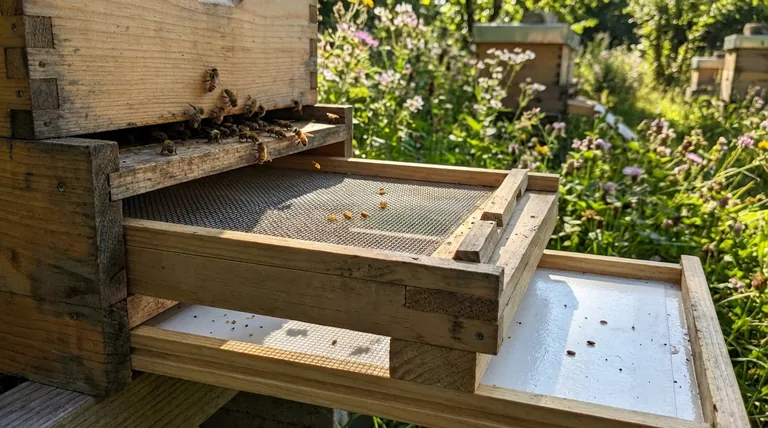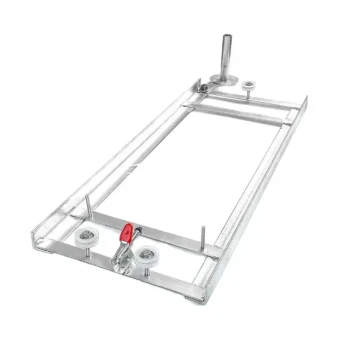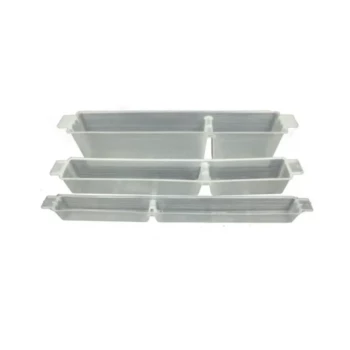The primary benefits of using a screened bottom board are superior hive ventilation and a significant advantage in managing Varroa mites. This piece of equipment allows air to circulate freely, which helps regulate temperature in the summer and reduce harmful moisture in the winter. Simultaneously, it provides a simple, non-chemical method for monitoring mite levels and contributes to a passive reduction in their numbers.
A screened bottom board is more than just a floor for your hive; it is a strategic tool for managing the two greatest threats to colony health: environmental stress and Varroa mite infestations.

The Core Function: Enhancing Hive Ventilation
Proper airflow is critical to a honey bee colony's health and productivity. A screened bottom board fundamentally changes the hive's internal environment by allowing for constant, passive air exchange.
Summer Cooling and Productivity
In hot climates or during intense summer heat, a colony must expend significant energy fanning its wings to cool the hive and prevent the wax comb from melting.
A screened bottom board provides a natural "air conditioning" effect. This ventilation reduces the internal temperature, freeing up foraging bees from fanning duties and allowing them to focus on collecting nectar and pollen.
Winter Moisture Control
Contrary to common belief, extreme cold is often less dangerous to a wintering colony than condensation. As the bee cluster generates heat, moisture from their respiration rises, condenses on the cold inner surfaces of the hive, and drips back down onto the bees.
A screened bottom board allows this moist air to escape, dramatically reducing condensation buildup. Keeping the cluster dry is paramount for winter survival, and this ventilation is one of the most effective ways to achieve it.
A Critical Tool for Varroa Mite Management
The Varroa destructor mite is the single greatest pest affecting honey bees worldwide. A screened bottom board offers a multi-faceted approach to monitoring and controlling this parasite.
Simplified Mite Monitoring
You cannot manage what you do not measure. A screened bottom board makes it easy to conduct a "mite drop count," one of the most common methods for estimating a hive's infestation level.
By sliding a white, sticky board (often called a "correx board" or "sticky board") under the screen for a set period, you can count the mites that naturally fall off the bees. This data provides a crucial snapshot of the mite population, informing your treatment decisions.
Passive Mite Reduction
When Varroa mites lose their grip and fall from a bee, a solid bottom board gives them a chance to climb back onto another host.
With a screened bottom board, a percentage of these mites fall completely out of the hive, unable to return. While this effect is modest—often estimated to reduce the mite population by around 20%—it provides a constant, non-chemical pressure against mite buildup.
A Cleaner, Healthier Hive
The screen allows other hive debris, such as wax cappings, pollen pellets, and even dead bees, to fall through. This self-cleaning feature helps reduce the habitat for other potential pests, like wax moths and small hive beetles, contributing to overall hive hygiene.
Understanding the Trade-offs and Considerations
While highly beneficial, a screened bottom board is not a universal solution. Its effectiveness is dependent on your climate and management goals.
The Decisive Factor: Climate
In very hot climates, a screened bottom board is almost always advantageous. In cold climates, however, the increased ventilation can be a liability during the winter.
Many beekeepers in northern regions use the removable insert or slide-in board that comes with most screened bottom boards. They keep the screen open during the summer and slide the board in to close off the bottom for winter, effectively turning it into a solid bottom board to conserve heat.
Passive Control Is Not a Cure
It is critical to understand that the passive mite drop from a screened bottom board is not a standalone treatment for Varroa mites.
Relying on it alone will allow mite populations to reach catastrophic levels. It must be used as one part of a comprehensive Integrated Pest Management (IPM) strategy that includes monitoring and, when necessary, active treatments.
The Solid Board Alternative
Traditional solid bottom boards are simpler and cheaper. They retain more heat, which can be beneficial for promoting faster brood rearing in the early spring. They also completely prevent any drafts or pests from entering from below.
Making the Right Choice for Your Apiary
Your choice of a bottom board should be a deliberate decision based on your specific environment and beekeeping philosophy.
- If your primary focus is aggressive mite management: A screened bottom board is an indispensable tool for monitoring and passive control.
- If you are beekeeping in a hot climate: A screened bottom board will significantly reduce heat stress on your colony and improve productivity.
- If you are beekeeping in a very cold climate: A screened bottom board with a removable insert offers the most flexibility, giving you ventilation in summer and an insulated floor in winter.
- If your goal is maximum simplicity and low cost: A solid bottom board remains a viable and historically proven option, but you will need other methods for mite monitoring.
Ultimately, adopting a screened bottom board empowers you with greater insight into your colony's health and provides a powerful advantage in maintaining it.
Summary Table:
| Benefit | Key Function | Impact on Colony |
|---|---|---|
| Ventilation | Allows passive air exchange | Regulates temperature, reduces moisture & condensation |
| Mite Management | Enables mite drop counts & passive reduction | Simplifies monitoring, provides non-chemical control |
| Hive Hygiene | Allows debris to fall through | Reduces habitat for pests like wax moths and hive beetles |
Ready to upgrade your apiary's health and productivity?
HONESTBEE supplies high-quality screened bottom boards and other essential beekeeping supplies to commercial apiaries and beekeeping equipment distributors through our wholesale-focused operations. Our equipment is designed to provide the durability and performance your business depends on for superior hive management.
Contact HONESTBEE today to discuss your wholesale needs and discover how our products can strengthen your beekeeping operation.
Visual Guide

Related Products
- Langstroth Screen Bottom Board for Beekeeping Wholesale
- Australian Pine Wood Langstroth Screen Bottom Board for Wholesale
- Langstroth Solid Bottom Board for Beekeeping
- Professional Insulated Winter Hive Wrap for Beekeeping
- Professional Galvanized Hive Strap with Secure Locking Buckle for Beekeeping
People Also Ask
- How does a screened bottom board assist with temperature control and pest management? A Key Tool for Modern Beekeeping
- What are the advantages of a screened bottom board? Boost Hive Health with Superior Ventilation & Pest Control
- How should the screened bottom board be used throughout the year? A Guide for Healthy Hives
- What are the benefits of using a screened bottom board for beehives? Improve Ventilation & Mite Control
- What are some considerations when choosing between solid and screened bottom boards? Optimize Hive Health & Pest Control



















